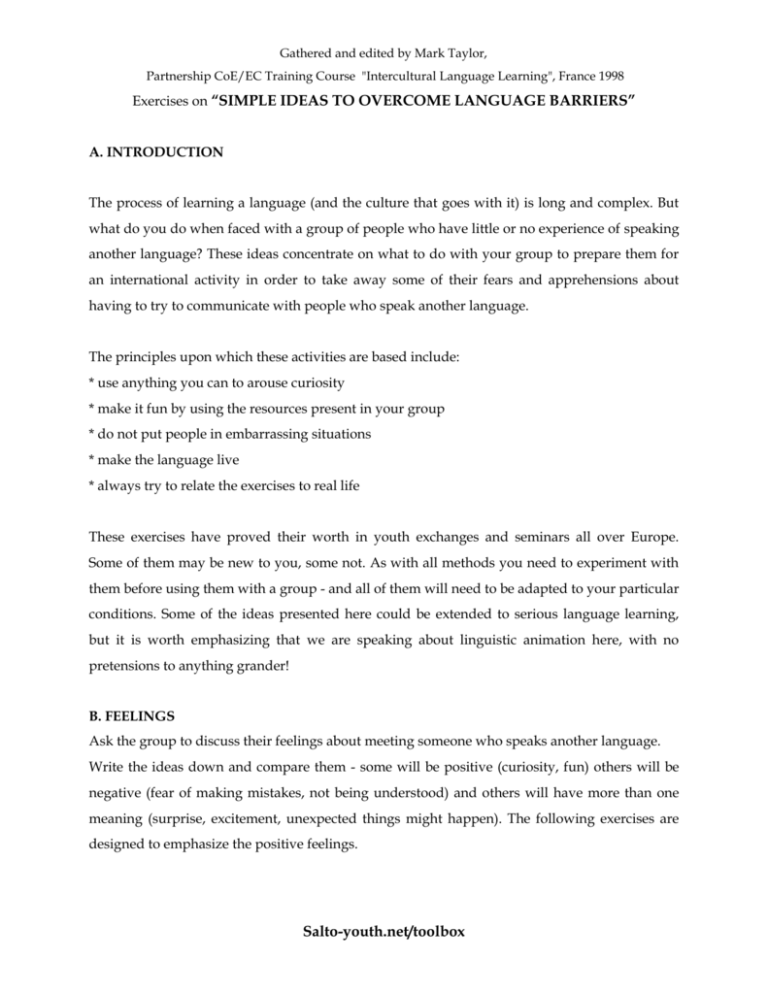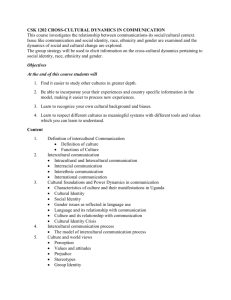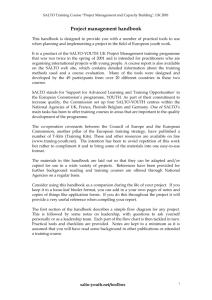Overcoming language barriers - Salto
advertisement

Gathered and edited by Mark Taylor, Partnership CoE/EC Training Course "Intercultural Language Learning", France 1998 Exercises on “SIMPLE IDEAS TO OVERCOME LANGUAGE BARRIERS” A. INTRODUCTION The process of learning a language (and the culture that goes with it) is long and complex. But what do you do when faced with a group of people who have little or no experience of speaking another language? These ideas concentrate on what to do with your group to prepare them for an international activity in order to take away some of their fears and apprehensions about having to try to communicate with people who speak another language. The principles upon which these activities are based include: * use anything you can to arouse curiosity * make it fun by using the resources present in your group * do not put people in embarrassing situations * make the language live * always try to relate the exercises to real life These exercises have proved their worth in youth exchanges and seminars all over Europe. Some of them may be new to you, some not. As with all methods you need to experiment with them before using them with a group - and all of them will need to be adapted to your particular conditions. Some of the ideas presented here could be extended to serious language learning, but it is worth emphasizing that we are speaking about linguistic animation here, with no pretensions to anything grander! B. FEELINGS Ask the group to discuss their feelings about meeting someone who speaks another language. Write the ideas down and compare them - some will be positive (curiosity, fun) others will be negative (fear of making mistakes, not being understood) and others will have more than one meaning (surprise, excitement, unexpected things might happen). The following exercises are designed to emphasize the positive feelings. Salto-youth.net/toolbox Gathered and edited by Mark Taylor, Partnership CoE/EC Training Course "Intercultural Language Learning", France 1998 C. SILLY CHANT Write the following "words" on a large piece of paper and hang it on a wall: ANA NA GRRRR PHUT BOOM! Say it slowly with the group, then increase the intensity, make it louder and softer, faster and slower (you can even include a little dance with it if you like). End with a big BOOM! Your group has just "learned" a new language with its rhythms, light and shade. D. THE ELEPHANT With a volunteer, mime two zookeepers taking an elephant out of its cage and washing it. The rest of the group should watch but not say anything. Ask for two volunteers to repeat the mime. [If you have time, others can try too]. The reflection after the exercise could concentrate on questions like these: * how did you understand what was going on? * what part did non-verbal communication play? * were there misunderstandings? * how did the messages change when two other people played the mime? * what lessons can we learn for communication with others? E. THE HOUSE AND ANIMAL Divide the group into pairs. Give each pair one marker pen and ask them to sit opposite each other with a piece of A3 paper taped to a table between them. Tell them that they will not be allowed to talk during the exercise which will last 5 minutes. Their task is to draw "a house and an animal" and they must do this with both partners holding the marker pen at the same time. No questions about what type of "house" or animal" are allowed! After the five minutes are over, compare the drawings. The discussion about this should raise some of the following points: * what different methods did you use to communicate? * how could you tell what the other was thinking? * what strategies could you imagine to improve things in the future? Salto-youth.net/toolbox Gathered and edited by Mark Taylor, Partnership CoE/EC Training Course "Intercultural Language Learning", France 1998 [Depending on the language level of your group, you may be able to run this exercise in the language which they want to learn, i.e., une maison et un animal; ein Haus und ein Tier; etc]. F. MUSIC Find a song in another language on a cassette or CD or record. Ask the group to listen to it: what kind of song is it? what kind of mood does it evoke? who is the song for? Play the song again and this time ask the group to try to write down as many of the lyrics as they can (don't worry about spelling!). Ask volunteers to read out their words - do they really appear in the song? how strange it sounds! can they understand anything? Play the song again and repeat as often as the group wants. You may find it useful to have a copy of the lyrics and a translation if you do not understand the language yourself. G. THE TANDEM Two native (or very good) speakers of a language play a short scene from everyday life. This could be going to a shop to buy some fruit, or to a cafe to drink something. You may wish to experiment with scenes which include a small element of conflict, e.g., "I asked for a coffee without milk!", or "I'm sorry sir, but I was next in line to take the lift", etc. The group is told to observe very closely the movements and speech of the actors. Two volunteers become the shadow of the actors and repeat their movements during the scene (but not the words). Then the scene is played again and the shadows repeat the movements and the speech of the actors. This may sound strange but the result is a kind of echo. This exercise is great fun and enables members of the group to appreciate more how language and gesture are linked. For groups where the members are not used to speaking in front of people it may help to do some exercises using "gibberish". This means acting out everyday scenes, but instead of using real words everyone just says "gibber gibber gibber" - with different emphases - all the time. Salto-youth.net/toolbox Gathered and edited by Mark Taylor, Partnership CoE/EC Training Course "Intercultural Language Learning", France 1998 H. THE PRINTED WORD Get some newspapers in another language. Find pages which have pictures, graphs, names of well-known personalities, etc etc. Make copies for everyone (or copy onto overhead sheets if you have an overhead projector). Ask the group the following questions: * describe what you see * what do you recognise? * are there any pictures or graphs? * are there any words which are similar to your language? * are there any figures or numbers? what could they refer to? * what kinds of meanings can we find in all of this? This exercise has proved successful in motivating people to try to read newspapers or journals in another language - they find they can understand far more than they thought possible. [See also: Tool Box 2: Texts as a Cultural Resource in Language Learning by John O'Regan and Rose Clark.] I. THE LANGUAGE RELAY Divide participants into groups of 4/5. For each group you make a copy of a couple of paragraphs drawn from a story, report or poem in your chosen language. Stick the copy on a wall far enough away from the group that they cannot read it from where they are sitting. Each participant takes it in turns to run to the copy, study it for 20 seconds, run back and write down as much as they can remember. Gradually, by helping each other, their goal is to reproduce their text exactly. You can set a time limit or stop when the first group has finished or let it continue until all have finished. Each group can then report their results, how difficult they found the exercise, how they managed to help each other and, of course, what they have understood from the text. This is a good activity for groups with mixed abilities. [This exercise comes from an idea outlined by Véronique Balthasart and Carla van der Straeten]. Salto-youth.net/toolbox Gathered and edited by Mark Taylor, Partnership CoE/EC Training Course "Intercultural Language Learning", France 1998 J. A DADA POEM! The Dada movement, which began in Zurich in 1916, produced many wonderful ideas in the arts and Dadaists were particularly playful with language. One of its founder members, Tzara, produced this recipe for writing a Dada poem: Take a newspaper. Take a pair of scissors. Select an article as long as you want your poem to be. Cut out the article. Then carefully cut out each of the words that form this article and put them in a bag. Shake gently. Then take out each scrap, one after the other. Conscientiously copy them in the order they left the bag. The poem will resemble you. And there you are, an infinitely original writer, with a charming sensibility, beyond the understanding of the vulgar. Why not try this method with your group using newspapers in your chosen language? Each participant should read out their poems in different styles. What meanings can they find in their poems, what shape have they given to their poems, how do they sound? and, even, would it be possible to make them grammatically correct? And, remember, a true Dadaist was also against Dada! [Tzara's recipe is quoted by Paul Auster in his Preface to “The Random House Book of Twentieth-Century French Poetry”]. K. THE NOTEBOOK Give each member of the group a notebook so they can write down any phrases they learn. Again it is not so important for the spellings or grammar to be perfect! (This idea comes from the film "Down By Law" in which the Italian character always does this - it can be amusing and useful to try this out). CONCLUSION Try everything you can. Adapt such exercises to your group and the materials you have. Language is obviously not the only way we communicate, but it is important to try to learn a little of the other's language - it shows respect, its useful and once you start its difficult to stop. N.B.: This paper concentrates on activities to get over some language barriers in international youth activities - it does not go into the more political aspects which we need to be considering: Why are some languages considered to be more important than others? Which languages are offered to be learnt at school and why? Which languages do we use in international youth work? Salto-youth.net/toolbox Gathered and edited by Mark Taylor, Partnership CoE/EC Training Course "Intercultural Language Learning", France 1998 Who is being excluded from participation? Whose voices are not being heard? What are the consequences of our choices? Philippe Crosnier de Bellaistre [a trainer living in Berlin] and Andi Krauß [from Bonn] started me off on this path of linguistic animation a few years ago - to them and to numerous workshop participants who have suffered with me many thanks! I would be happy to hear of other exercises in a similar vein. Mark Taylor, Strasbourg, June 1996 Salto-youth.net/toolbox








